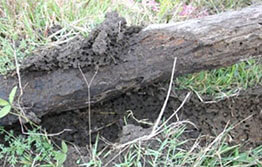Fire ant baiting continues across South East Queensland
The aggressive bait treatment program for fire ants is focusing on halting their spread south into the Gold Coast, west into farming areas in the Lockyer and across new housing development sites.

National Red Imported Fire Ant Eradication Program Director Sarah Corcoran said we are nearing completion of the first round of bait treatment and will start the second round shortly.
“Biosecurity Queensland applies successive rounds of bait to ensure that no fire ants are missed,” she said.
“We used this approach against fire ants in Gladstone last year and it was so successful we are now on track to declare complete eradication in Gladstone in only two years.
“The bait includes an insect growth regulator that is commonly used in mosquito control programs and flea collars, and is not harmful to other animals or humans.
“The ants pick the bait up, feed it to their queen who then becomes sterile and the colony dies out over time.”
The current round of bait treatment will continue until May 2016. Bait treatment is most effective in the warmer months when fire ants are out and about foraging for food. Residents who live in the treatment area will be contacted by Queensland Government Fire Ant Program staff if access is required to their property.
Ms Corcoran said it is crucial that people in South East Queensland remain vigilant for fire ants even if they don’t live in fire ant restricted area.
“A fire ant colony was recently found in Norman Park close to Brisbane’s CBD, just outside the current fire ant restricted area,” she said.
“A member of the public identified the fire ants and reported them to Biosecurity Queensland.
“Because of the quick action of this person, we were able to destroy the nest and then confirm no other colonies were in the area.
“It’s essential that residents and businesses continue to support the Fire Ant Program as early detection means the colonies can be treated before they have a chance to spread.”
To find out if your suburb is affected, to report fire ants or for more information, visit www.daf.qld.gov.au/fireants or call 13 25 23.
